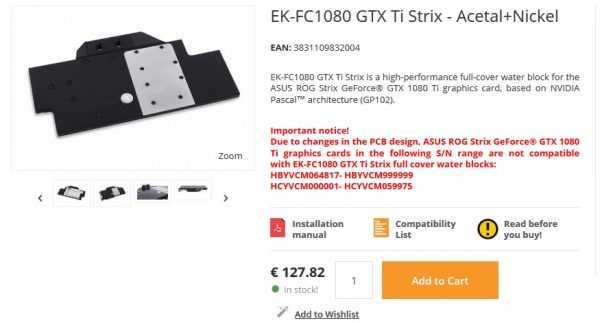In the tech world, revised PCB designs aren't exactly uncommon and often go unnoticed. However, this week we've come across the rare occasion where a PCB design change has introduced some compatibility issues. Recently, Asus introduced a revised PCB design for the ROG Strix GTX 1080Ti, which EKWB has warned will introduce incompatibility issues with some of its waterblocks.
If you're planning on splashing out on an ROG Strix GTX 1080Ti soon with the intention of watercooling it, then you'll want to pay careful attention to the serial number on the box. Over on the EKWB website, the water block provider has issued a warning for customers, saying cards in the following S/N range won't be compatible with the EK-FC1080 GTX Ti Strix full cover water block or the EK-MLC GPU module:
- HBYVCM064817- HBYVCM999999
- HCYVCM000001- HCYVCM059975
Based on the serial numbers, these particular ROG Strix GTX 1080Ti cards were manufactured after November 2017, so it is a relatively new change. If you're picking up an ROG Strix GTX 1080Ti with the intention of using an EK waterblock, then take heed, you may be able to get a compatible waterblock elsewhere.
KitGuru Says: PCB design changes rarely cause issues like this. Perhaps we'll see EKWB release a revised waterblock to fit the new Strix PCB design, though nothing has been confirmed on that front.
 KitGuru KitGuru.net – Tech News | Hardware News | Hardware Reviews | IOS | Mobile | Gaming | Graphics Cards
KitGuru KitGuru.net – Tech News | Hardware News | Hardware Reviews | IOS | Mobile | Gaming | Graphics Cards




It might be a bit of a annoyance but Asus and any other company can change a products design when ever they want to as long as it does not change the products specs itself & it works as advertised on the spec sheet. They do not have to take into consideration what other companies are making for those products. Well unless all companies involved have contracts agreeing to do things a certain way for a period of time.
Now it is a let down for the end users that depend on advertised products working with other products as in cooler changes etc etc and then to find out company A changed something & now company B’s product no longer works or fits right on company A’s product. But there was nothing illegal done here just Asus being Asus and most likely either upgrading the design or found a cheaper way to do it.
True, but it’s a bit of common courtesy to enthusiasts and vendors of water blocks to inform said vendors ahead of time to coordinate and manage any potential backlash. If Asus had added “-A” to the end, then at least it would be a heads up to anyone thinking about water cooling to do some research or ask EK about compatibility.
Of course Asus has the right. I don’t think the author is arguing otherwise. It’s just poor communication and risk management.
Yes it would have been a lot better if Asus would have said something to the parties that be about the change up so they could make the changes to their products as well that’s like you said common courtesy. But they didn’t and now face a bit of backlash because of that from the companies involved as well as end users. They have no legal reason to do so but it would have been nice if they let it be known so other parties could get ready as well I guess.
What would be really nice is to see pictures of the old and the new PCB’s so we can see just how much has changed. I am sure Kitguru and others will have the pic’s soon enough for us to gawk at..lol
I can see it now:
*moved one screw hole two millimeters to the right for “structural integrity”* just like Intel on 2011-3 by moving a single pin from one corner of the package to the opposite corner lol.
I know you are just kidding around but you might be very close to the actual truth of what Asus did to change the design…lol
I’m almost more curious about what the change to the PCB was and why.